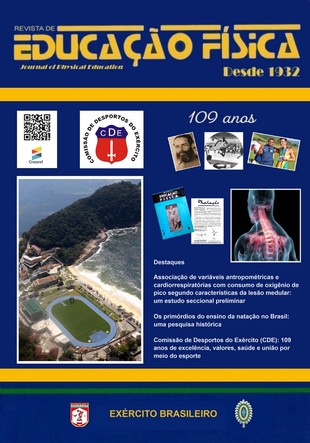Abstract
Introduction: With the arrival of the Portuguese royal family in Brazil, in 1808, several sports practices were inserted in the country, as an example we can highlight fencing, dance, gymnastics, rowing, turf and swimming.
Objective: To analyze how swimming, in its primordial form, was systematized and taught in Brazil, considering the historical context in which it was inserted.
Methods: The main theoretical framework of the study was the didactic-pedagogical practices applied in the teaching-learning process in the early days of swimming education in Brazil.
Results and Discussion: In the historical cut between 1932 and 1934, we mapped the total of five articles referring to the teaching of swimming in the Journal of Physical Education (REF/JPE).
Conclusion: The teachers, holders of a certain prestige in the field of Physical Education, were able to select the content that they believed to be the most important in that historical period to be published by the Journal.
References
Melo VA de. A Educação do Corpo nas Escolas do Rio de Janeiro do Século XIX.. 1a edição. Rio de Janeiro: 7Letras; 2020.
Neto AF. A Pedagogia no Exército e na Escola: a Educação Física (1920-1945). Motrivivência. 1999;(13): 35–62. https://doi.org/10.5007/%x.
Bourdieu P. Usos sociais da ciência: Por uma sociologia clínica do campo científico.. 1a edição. São Paulo: Editora Unesp; 2004.
Gomes R de S, Novaes RC, Telles S de CC. Revolução de 1930 no Brasil e interfaces com a Revista de Educação Física do Exército Brasileiro (1932-1934): uma pesquisa histórica. Revista de Educação Física / Journal of Physical Education. 2023;92(2): 268–280. https://doi.org/10.37310/ref.v92i2.2943.
Escola de Educação Física do Exército (EsEFEx). Almanaque da Escola de Educação Física do Exército (EsEFEx). Escola de Educação Física do Exército (EsEFEx); 2021. https://www.esefex.eb.mil.br//Almanaque [Accessed 2nd July 2024].
Cassani JM, Ferreira Neto A, Carvalho LOR de, Santos W dos. Fundamentos para educação física: a circulação da biologia e da psicologia na imprensa periódica de ensino e de técnicas (1932-1960). Revista Brasileira de Educação. 2019;24: e240060. https://doi.org/10.1590/S1413-24782019240060.
Pinheiro JR. Natação. Revista de Educação Física / Journal of Physical Education. 1932;1(2): 51–54.
Sobrinho C de C. A Natação e as Guerras. Revista de Educação Física / Journal of Physical Education. 1956;25(1): 3–3.
Melo VA de. Enfrentando os desafios do mar: a natação no Rio de Janeiro do Século XIX (anos 1850-1890). Revista de História (São Paulo). 2015; 299–334. https://doi.org/10.11606/issn.2316-9141.rh.2015.98755.
International Olympic Committee. Johnny Weissmuller. Olympics.com. https://olympics.com/en/athletes/johnny-weissmuller [Accessed 2nd July 2024].
Pinheiro JR. Prognósticos Olímpicos de Natação. Revista de Educação Física / Journal of Physical Education. 1932;1(2): 1–1.
Silva AL dos S, Staudt JL. “Mais um belo modelo da nova geração que a Educação Física está construindo no Brasil”: sadio, forte, belo e branco. Revista Brasileira de Educação Física e Esporte. 2021;35(1): 95–107. https://doi.org/10.11606/issn.1981-4690.v35i1p95-107.

This work is licensed under a Creative Commons Attribution 4.0 International License.
Copyright (c) 2024 Journal of Physical Education
